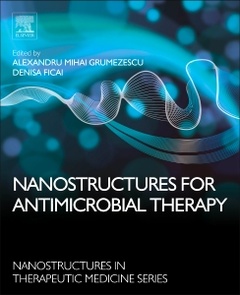Nanostructures for Antimicrobial Therapy Nanostructures in Therapeutic Medicine Series
Coordonnateurs : Ficai Anton, Grumezescu Alexandru Mihai

Nanostructures for Antimicrobial Therapy discusses the pros and cons of the use of nanostructured materials in the prevention and eradication of infections, highlighting the efficient microbicidal effect of nanoparticles against antibiotic-resistant pathogens and biofilms.
Conventional antibiotics are becoming ineffective towards microorganisms due to their widespread and often inappropriate use. As a result, the development of antibiotic resistance in microorganisms is increasingly being reported. New approaches are needed to confront the rising issues related to infectious diseases. The merging of biomaterials, such as chitosan, carrageenan, gelatin, poly (lactic-co-glycolic acid) with nanotechnology provides a promising platform for antimicrobial therapy as it provides a controlled way to target cells and induce the desired response without the adverse effects common to many traditional treatments.
Nanoparticles represent one of the most promising therapeutic treatments to the problem caused by infectious micro-organisms resistant to traditional therapies. This volume discusses this promise in detail, and also discusses what challenges the greater use of nanoparticles might pose to medical professionals. The unique physiochemical properties of nanoparticles, combined with their growth inhibitory capacity against microbes has led to the upsurge in the research on nanoparticles as antimicrobials. The importance of bactericidal nanobiomaterials study will likely increase as development of resistant strains of bacteria against most potent antibiotics continues.
1. Antimicrobials: Meeting challenges of antibiotic resistance and drug delivery2. Nano-antimicrobials: Activity, benefits and weaknesses3. Sensitive And Selective Assay Of Antimicrobials On Nanostructured Materials By Electrochemical Techniques4. Antimicrobial Polymeric Nanostructures5. Thin degradable coatings for optimization of osteointegration associated with simultaneous infection prophylaxis6. Nanostructure and Nanomedicine of Anti-microbial Agents for Neuroinfectious of Neurodegenerative Diseases: Current and Future Perspectives7. Nanocarriers and Their Potential Application as Antimicrobial Drug Delivery8. Delivery of Antimicrobials by Chitosan Composed Therapeutic Nanostructures9. Antimicrobial thin coatings prepared by laser processing10. Antimicrobial Photo Dynamic Therapy With Nanoparticle Vs Conventional Photosensitizer In Oral Diseases11. The Applications of 19F Magnetic Resonance Spectroscopy and Imaging for the Study of Nanostructures used in Antimicrobial Therapy12. Esential oils and nanoparticles: new strategy to prevent microbial biofilms13. Nanocarriers Assisted Antimicrobial Therapy Against Intracellular Pathogens14. Implications, Mechanisms and Applications of Nanomaterials with Antimicrobial Properties15. Outer Membrane Vesicles Of Gram-Negative Bacteria: Nanoware For Combat Against Microbes And Macrobes16. Organic nanocarriers for the delivery of anti-infective agents17. Nanocarriers for plant-derived natural compounds18. Fullerene derivatives in photodynamic inactivation of microorganisms19. Silver iodide (AgI) nanoparticles as an anti-biofilm agent. A case study on gram-negative biofilm forming bacteria20. Nanoformulations for the Therapy of Pulmonary Infections21. Nanocarriers for photosensitizers for use in the antimicrobial photodynamic therapy22. Zinc oxide nanostructures: new trend in antimicrobial therapy23. Copper based Nanoparticles as Antimicrobials24. Antimicrobial Applications of Superparamagnetic Iron Oxide Nanoparticles: Perspectives and Challenges25. Silica nanoparticles as a basis for efficacy of antimicrobial drug26. Silver nanoparticles as antimicrobial agents: past, present, and future27. Encapsulation of lethal, functional and therapeutic medicinal nanoparticles and quantum dots for the improved diagnosis and treatment of infection28. Advanced Nanocomposites with Noble Metal Antimicrobial Nanoparticles: how to design a balance among antimicrobial activity, bioactivity and safe delivery to the place of infection29. Clinical development in antimicrobial nanomedicine: towards novel solutions30. The citation classics in antimicrobial nanostructures
Anton Ficai is Assistant Professor at the Department of Science and Engineering of Oxide Materials and Nanomaterials, Faculty of Applied Chemistry and Materials Science, University Politehnica of Bucharest, Romania. His research activity is mainly focused on biomaterials for bone healing and treatment. He has been involved in various projects dealing with bone cancer treatment and pain management (especially associated with bone cancer). His patent application related to bone cancer treatment was recently awarded with the Gold Medal by “BRUSSELS INNOVA - The World Exhibition on Inventions, Research and New Technologies. Anton Ficai is also active in the field of synthesis and characterization of drug delivery systems, synthesis and characterization of nanomaterials, biomaterials or antimicrobial materials, etc. Dr Ficai serves on he Editorial Board of three journals, and has also been the guest editor of Current Pharmaceutical Design.
He has been awarded over 20 prizes for his academic and research activity, and was invited as Visiting Professor of University of Beira Interior. He has given oral presentations at more than 10 international conferences and published over 100 papers and 12 books and book chapters.
Dr. Grumezescu is Assistant Professor at the Department of Science and Engineering of Oxide Materials and Nanomaterials, in the Faculty of Applied Chemistry and Materials Science, with a second affiliation to the Faculty of Medical Engineering, at the Politehnica University of Bucharest in Romania. He is an experienced and oft-published researcher and editor in the field of nano and biomaterials, and he is the Editor-in-Chief of three journals: Biointerface Research in Applied Chemistry, Letters and Applied NanoBioScience, and Biomaterials and Tissue Engineering Bulletin. He also serves as editor or guest editor for several notable journals. Dr. Grumezescu has published 150 peer-reviewed papers, 20 book chapters, 6 co-authored books and 11
- Shows how nanoantibiotics can be used to more effectively treat disease
- Discusses the advantages and issues of a variety of different nanoantibiotics, enabling medics to select which best meets their needs
- Provides a cogent summary of recent developments in this field, allowing readers to quickly familiarize themselves with this topic area
Date de parution : 05-2017
Ouvrage de 722 p.
21.5x27.6 cm
